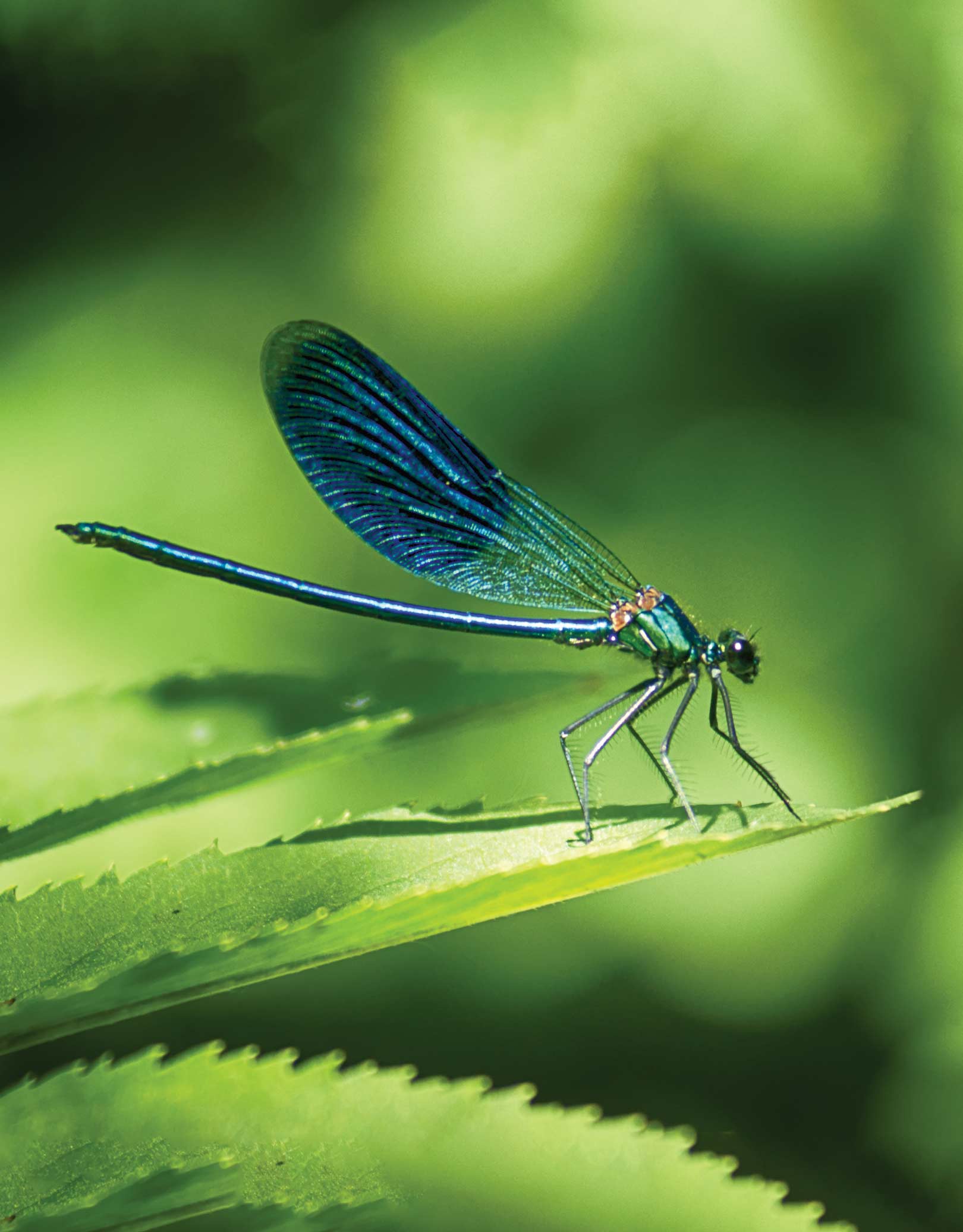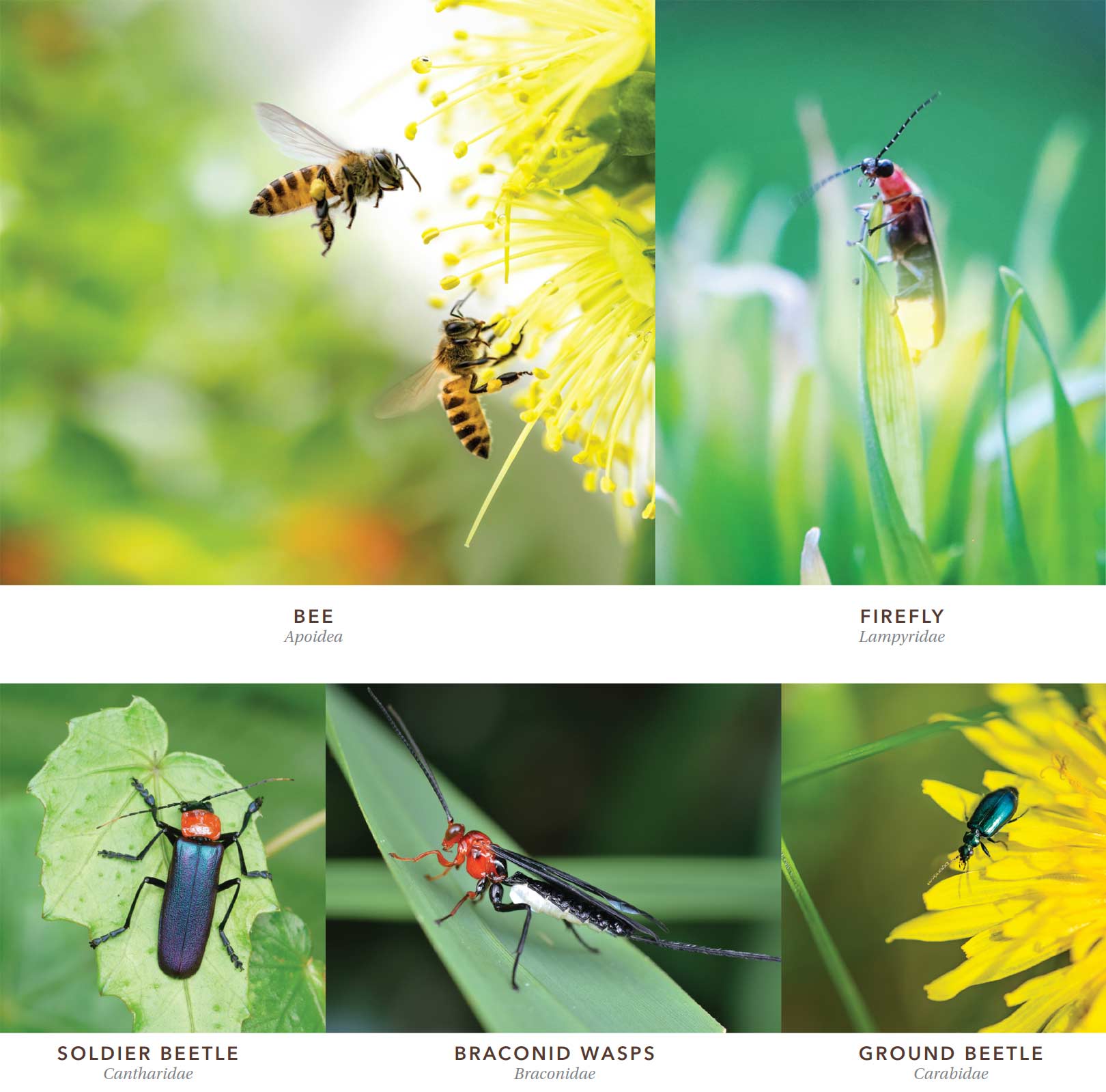

Summertime means bugs. As the season unfolds we can actually tell what stage of summer we are in by the appearance of certain insects: blackflies in May, June bugs in June, mosquitoes in July, and monarch butterflies in August. Although we’ve heard a lot about invasive species like LDD moths (gypsy moths), Boxelder bugs, Asian beetles, and now the worrisome Asian giant hornets (a.k.a. “murder hornets”), there are some heroes of the insect world that play a vital role in pollination and the management of pest insects, and act as a source of food for other important bugs as they decompose. These beneficial insects not only help to reduce the use of pesticides, but have also been proven to help produce healthier and tastier fruits and vegetables. They even help reduce weeds – and therefore the amount of money we spend caring for our gardens.
BEES (Apoidea) | Bees are widely recognized for their crucial role as pollinators. Last year Watershed featured the efforts of local organizations like the Campbellford/Seymour Community Foundation (CSCF) in their efforts to improve pollinator habitats. They joined other organizations like Bee City Canada and initiated campaigns to raise awareness of environmental projects among local businesses and schools.
At the time, Martha Murphy, the Executive Director of CSCF, had raised the alarm on what it would mean to lose these beneficial bugs in our area. She stated, “If bee populations continue to dwindle, we’ll start to see the effects on our local produce like apples, blueberries, raspberries and even squash, which are dependent on pollination. It would not only impact our farmers, but our whole community.”
As crucial as bees are to our farming community, bees cannot do it alone. Here are a few unsung heroes of the insect world that support pollination and pest control.
GREEN LACEWINGS (Chrysopidae) | Green lacewings are delicate-looking insects with soft, narrow bodies and four finely veined, lacy wings that fold roof-like over the body when at rest. Their larvae eat aphids, thrips, whiteflies, leafhoppers, spider mites and mealybugs. The adult green lacewings roam around plant foliage looking for prey – pest eggs, nymphs or adults. They can also tolerate wide temperature ranges, and as a bonus, they get along with other beneficial insects.
FIREFLIES (Lampyridae) | Lighting up our gardens at dusk with their bioluminescence, fireflies are primarily nocturnal, although some species are diurnal. They are soft-bodied beetles about 10–25 mm (or up to 1 inch) in length. Their flattened, dark brown or black body has an orange or yellow marking. Fireflies are found in every continent except Antarctica, and lucky for us, 19 of the almost 30 types found in Canada are in Ontario.
They are especially beneficial as their larvae eat slugs and snails. These unique beetles are also beneficial to the soul – for who can resist their magical light show?
SOLDIER BEETLES (Cantharidae) | Soldier beetles get their name because they look like British “Redcoats” with their reddish-brown shell and black wings. Soldier beetles may not light up like their firefly relatives, but these under-appreciated pollinators feed on grasshoppers, caterpillars, and aphids. They also have saved countless bean plants and potatoes from the Mexican bean beetle and the Colorado potato beetle. They are attracted to plants that have compound blossoms, such as Queen Anne’s lace and yarrow.
DRAGONFLIES AND DAMSELFLIES (Anisoptera, Zygoptera) | Dragonflies are the larger of the two species and can be distinguished by their unfolded wings, which extend horizontally from their bodies. Damselflies are more delicate, with a slender body and wings that fold along their backs when they are resting. Damselflies often have glistening metallic abdomens and shimmering, emerald-margined wings. There are at least 170 species in Ontario.
Both dragonflies and damselflies help to keep down populations of mosquito larvae, mosquitoes and other aquatic bugs.
GROUND BEETLES (Carabidae) | The ground beetle is especially important to apple growing, and they are primarily found in fruit tree orchards and agricultural fields. They look like what you think a typical beetle should look like – six legs, black in colour, with visible mouthparts. Ground beetles live underground in loose soil and hunt mainly on the soil surface. In addition to being beneficial predators as adults, the burrowing larvae of these beetles seek out and feed on underground pests like apple maggot pupae, codling moth larvae, aphids and mites. Why do these beetles have a special place in a gardener’s heart? They feed on weed seeds as well! These weed seed predators can have a serious impact on weed management on the farm (studies show up to a 30 percent reduction in weeds). They also shift their diet based on food availability, moving back and forth between insects and weed seeds, and this flexibility allows them to survive in farm environments when any single type of pest or weed is not available. Unfortunately, the use of pesticides on crops is altering their already slow reproductive rate and has greatly impacted their numbers.
LADYBUGS (Coccinellidae) | Perhaps the most recognizable of all bugs with their oval, dome-shaped bodies and six short legs. Depending on the species, they can have spots, stripes, or no markings at all and a black head with white patches on either side. People have long recognized the ladybug as a beneficial insect because of its voracious appetite for aphids. In its lifetime, a ladybug can consume as many as 5,000 aphids. They lay hundreds of eggs in the colonies of aphids and other plant-eating pests so that when the larvae hatch, they immediately begin to feed.
BRACONID WASPS (Braconidae) | Braconid wasps are small, with narrow waists, long antennae, ant-like heads, and a long black “ovipositor” extending from their backs. Most importantly, braconid wasps do not sting. Adults lay eggs on, or in, soft-bodied caterpillars including cabbage worms, the dreaded tomato hornworms, and other garden pests. They are attracted by the smell of caterpillars munching on plant leaves. The braconid larvae feed inside their living hosts, weakening or killing them. Flower nectar and pollen are major energy sources for braconid wasps. Flowers with small florets, including most herbs, are ideal. Leaving a few broccoli stalks through winter can provide shelter for braconid species that attack cabbage worms. Beneficial insects play a vital role in pollination, the management of pest insects, and in the decomposition of organic matter. If we commit to attracting even one of them to our yards, gardens, and crops, we can make a small but impactful difference to our local environment. More importantly, we can let the bugs do the work and avoid spraying pesticides.
Beneficial bugs not only help to reduce the use of pesticides, but have also been proven to help produce healthier and tastier fruits and vegetables.
Story by:
Micol Marotti




